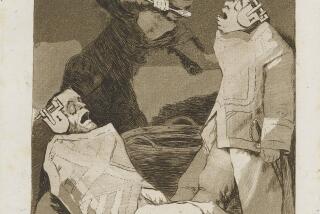VALLEY WEEKEND : Indelible Images of the Holocaust Haunt Finegood Art Gallery : Works by death camp survivors, their children and sympathizers make up ‘Witness and Legacy.’ A theme of hope arises amid the horror.
Charred, dismembered figures rest carefully on a polished wooden floor.
Though they are only simulations of burned human remains created from burlap, wood, paint and glue, these few sculptures serve as a startling reminder of the millions who died in the death camps under the Nazi regime of World War II.
They also represent hope.
As part of the Finegood Art Gallery’s latest exhibit, titled “Witness and Legacy: Contemporary Art About the Holocaust,” the somber, life-size figures artist Shirley Samberg calls “Wrappings” will be featured with more than 80 other works--paintings, sculptures, photographs and interactive room-sized installations inspired by the memories and childhood stories of the Holocaust experience.
The need for such an exhibit, said Sandra Kussin, president of the Women’s Division of the Jewish Federation Council of Greater Los Angeles, is to remind the Jewish and non-Jewish community that, even if the past cannot change, there is still hope for the future.
“It’s only very recently that Holocaust art has been thought of as formal art,” Kussin said. Because much of the work produced stems from harsh images and memories of the Holocaust, the subject matter reflects an era that many people may want to forget, she said.
But it is remembrance that Kussin wants to emphasize through the artwork and especially among children of the community. Created by survivors of the Holocaust, children of survivors and sympathizers, recurrent themes such as human destruction, degradation and the ultimate search for dignity haunt many of the paintings, sculptures and embroideries.
*
It is the symbolism laced through each piece, said Wendy Kaplan Friend, curator and director of the project, that makes them worthy of more than just a glance.
Jerome Witkins’ five oil-painted panels titled “The Bathing Session,” for example, expose the raw humiliation suffered by those invited into the brown houses. “It was a place,” said Kaplan Friend, “where people would go in and not necessarily come out.”
Marlene E. Miller’s sculpture “Schlafwagon: Who Will Say Kaddish for Them?” includes marionette-like figures representing the dead, whom the Nazis referred to as puppets, slumped together and set atop a black carriage. Trudie Strobel’s “Russia 1942” is an embroidered tapestry made with more than 900 stitches, re-creating a scene from the artist’s childhood in which a Nazi soldier takes her doll.
It is these types of images, said Kaplan Friend, that still torment many of the artists, even those who only heard stories of the Holocaust.
“You can’t tell the difference between the generations,” said Kaplan Friend. “That’s what’s so phenomenal.”
Westlake artist Danuta agreed. As a child in Poland, family vacations after the war included trips to the concentration camps, she said, where her grandfather had died. Those images, she said, overflowed into her artwork many years later, even when she tried to avoid them.
“As long as I remember, I have always been exposed to (the Holocaust),” said the 44-year-old painter whose wall-size painting “Silence I” depicts children from the camps witnessing the death of the mother-figure. “I felt for those people,” she said. “Especially the kids.”
Danuta said she hopes parents will encourage their children to see the exhibit, despite fears that such images may seem too gruesome for young eyes.
“We cannot protect our children and put them in a protective shell and not expose them to the issues that have occurred for thousands of years,” she said.
Originally developed by the Minnesota Museum of Art, “Witness and Legacy” includes work by 27 American artists, six of whom are from Southern California. With the assistance of the Jewish Federation Valley Alliance and the Finegood Art Council, sponsors of the show, Kussin was able to lead the project to its present location, where it will have its sole West Coast exhibit.
“The show was so brilliant that we felt it really needed to be seen,” she said. “We don’t want people ever to forget (the Holocaust). This will certainly help our children to remember.”
(BEGIN TEXT OF INFOBOX / INFOGRAPHIC)
DETAILS
* WHAT: “Witness and Legacy: Contemporary Art About the Holocaust.”
* WHEN: Sunday, public reception with lectures presented by the artists from 11 a.m. to 4 p.m. The exhibit runs through April 16. The exhibit hours will be 10 a.m. to 6 p.m. Sunday, 10 a.m. to 9:30 p.m. Monday through Thursday, 10 a.m. to 3:30 p.m. Friday, closed Saturday.
* WHERE: Finegood Art Galley at the Bernard Milken Jewish Community Campus, 22622 Vanowen St., West Hills.
* HOW MUCH: Free.
* CALL: (818) 587-3218; group tours: (818) 587-3255.
More to Read
The biggest entertainment stories
Get our big stories about Hollywood, film, television, music, arts, culture and more right in your inbox as soon as they publish.
You may occasionally receive promotional content from the Los Angeles Times.










